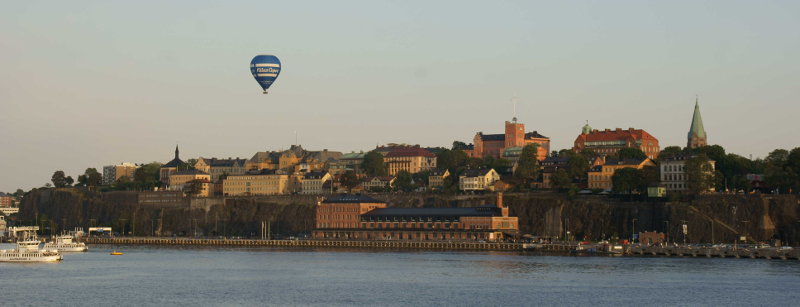
Pictures
Day 1: Saturday, 14 July 2018
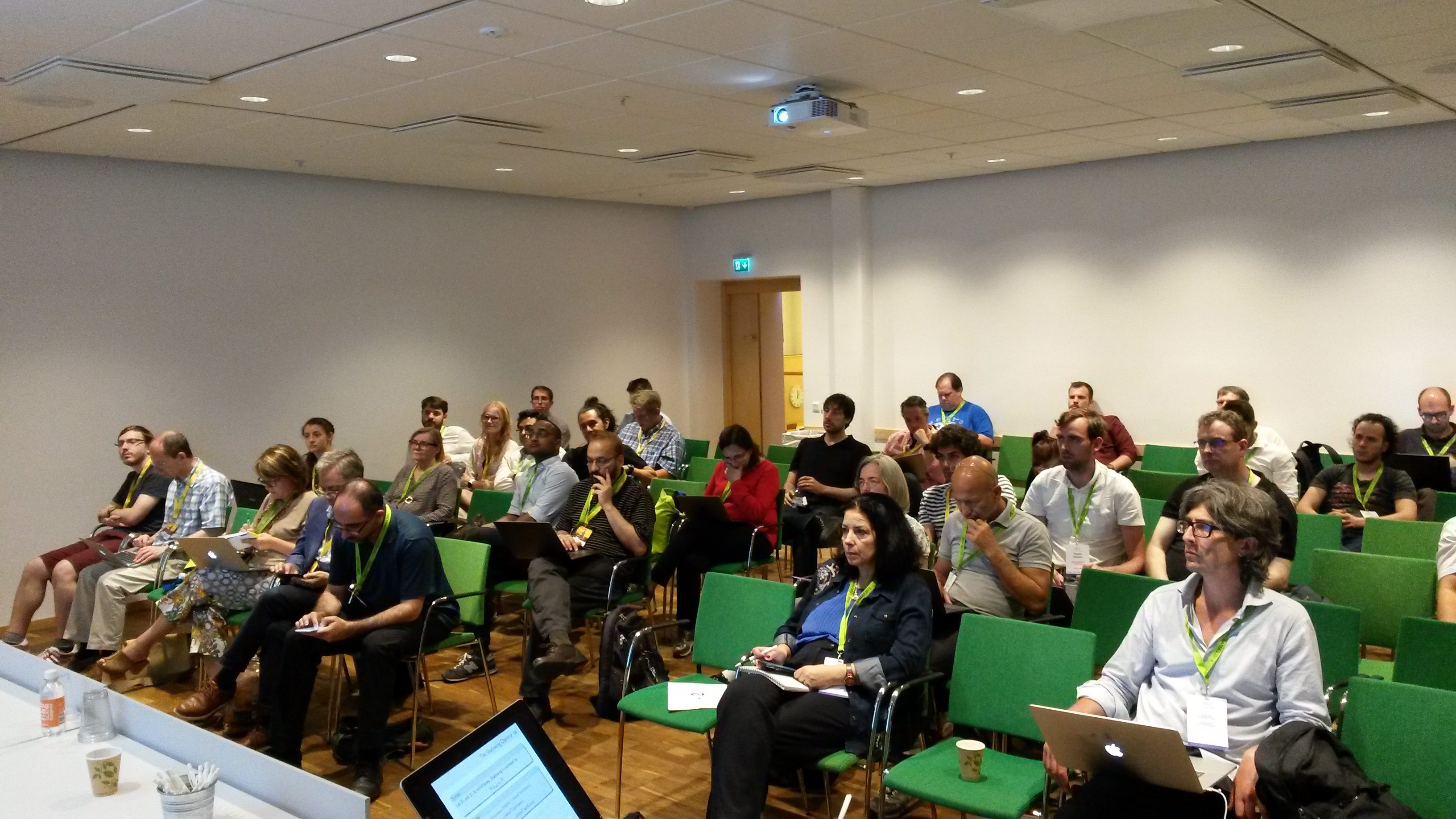
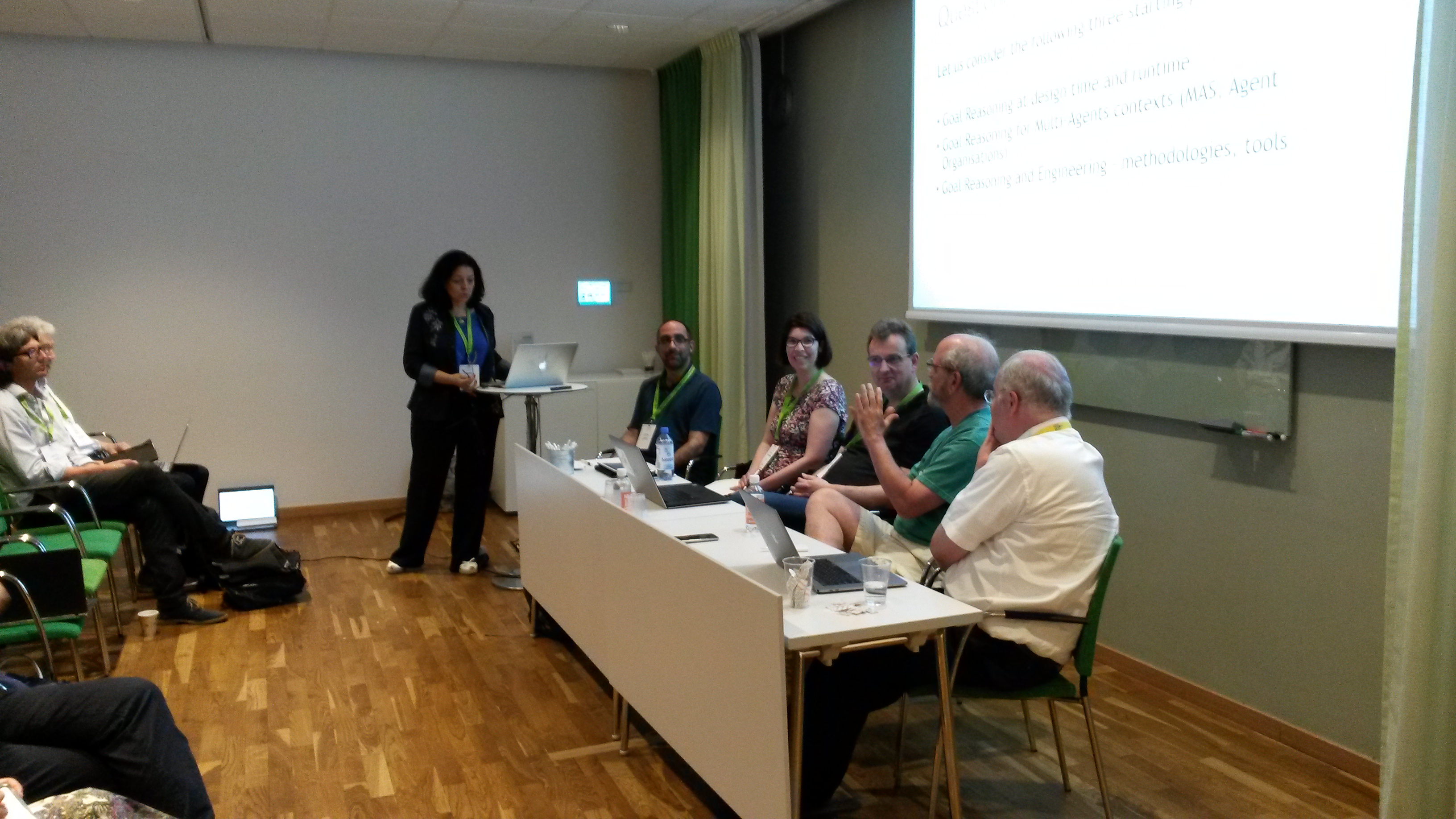
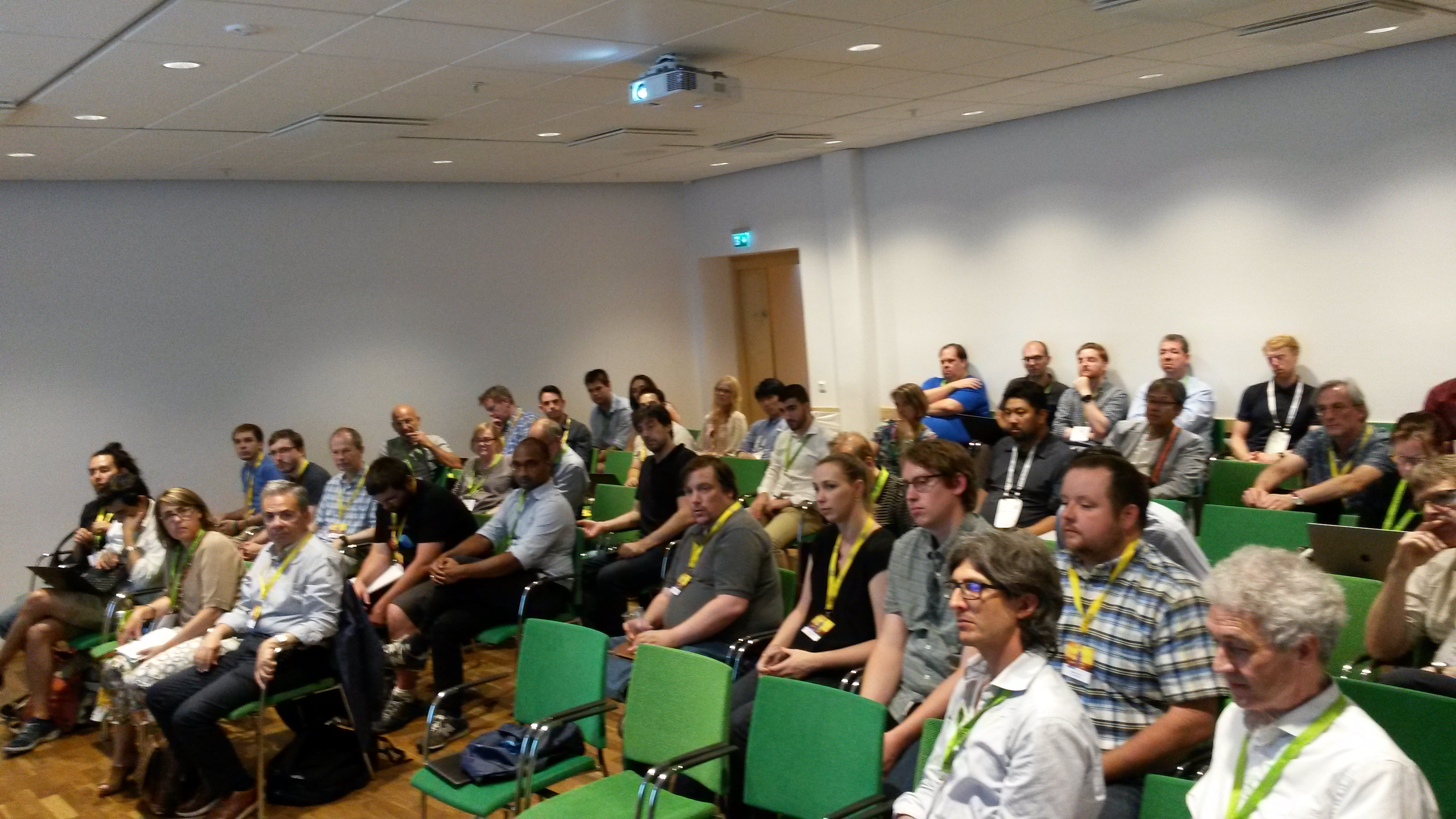
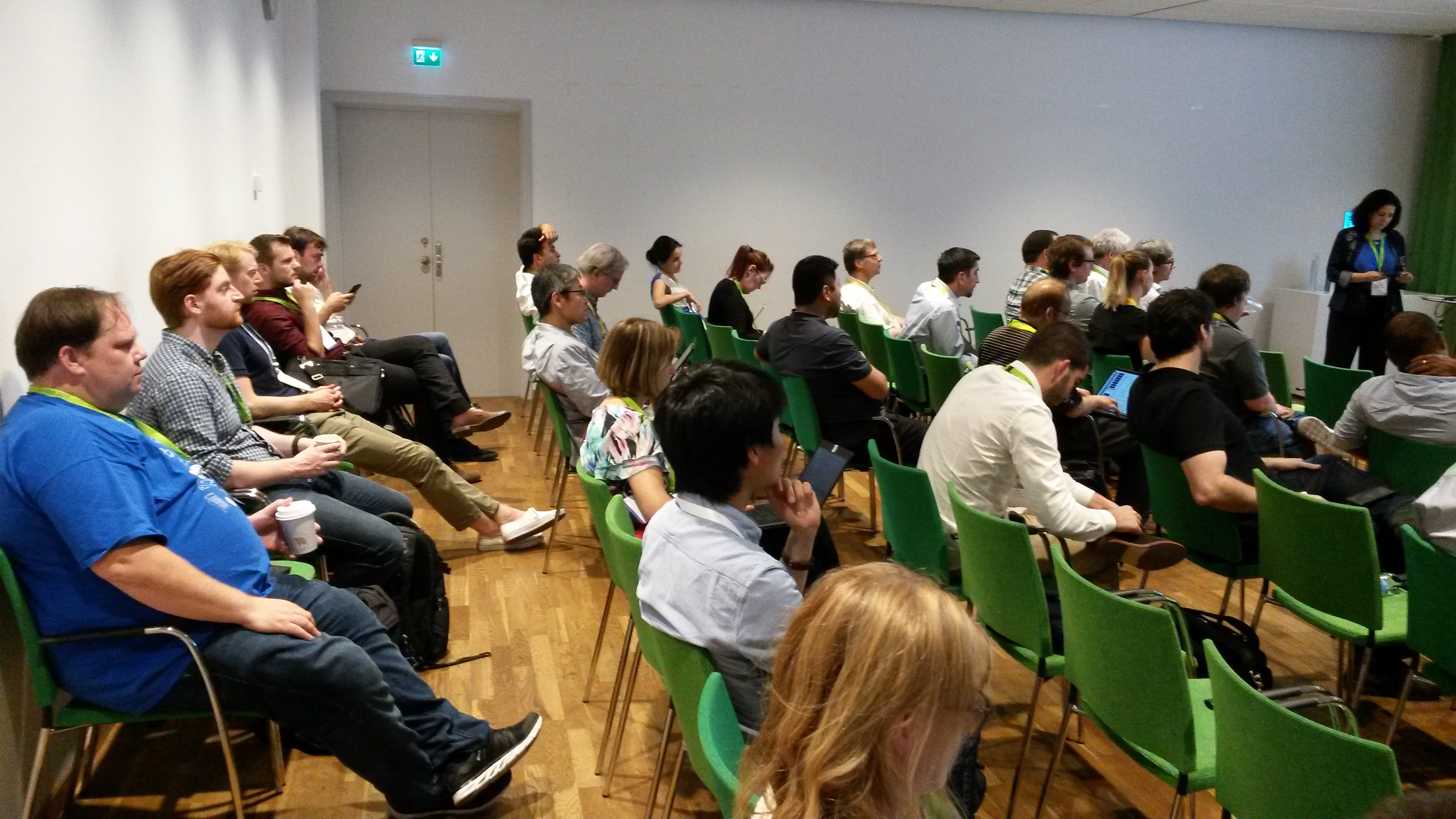
Day 2: Sunday, 15 July 2018


Papers accepted for presentation & keynote
 The EMAS REPORT has been submitted to the ACM SEN
The EMAS REPORT has been submitted to the ACM SEN
KEYNOTE: Simon Mayer, TU Graz and Pro²Future GmbH
Title: Autonomous Agents for Flexible Hypermedia Systems (EMAS18-invited-talk-slides.pdf)
Abstract: The Web of Things community used to be driven by the application of Web technologies to enable flexible mashups of smart devices on top of the Internet of Things, an objective that we consider accomplished (from a research standpoint) in many different domains ranging from smart homes and cars to dynamic factories in the Industrie 4.0 paradigm. One of the next big things for us – consequently, perhaps, from an AAMAS standpoint – is to increase the autonomy of our Web-enabled devices and their understanding of one another, for instance by outfitting them with semantic descriptions of their properties and functions and, sometimes, even bestowing agency upon them. In this talk, I discuss this convergence that will enrich real-world devices with AAMAS technologies, and open up real-world applications to the AAMAS community, while examining important properties of the Web architecture that support flexibly interacting autonomous things on the Web.
Short Bio: Dr. Simon Mayer is leading the research group on Cognitive Products at Pro²Future. Before, Simon was part of Siemens' Web of Things research group in Berkeley, California in the role of a Senior Key Expert for Smart and Interacting Systems. His main research topics are aspects of integrating smart things into the Web, their semantic description, and infrastructures that support human users and machines in finding and interacting with the information and services provided by such devices. As a visiting researcher at the Laboratory for Manufacturing and Productivity at MIT in the year 2012, he was also working on robustly and securely bringing live data from automobiles to the Web. Simon graduated with a PhD in computer science from ETH Zurich.
PROGRAMMING AGENTS AND MAS
Álvaro Fernández Díaz, Clara Benac Earle and Lars-Ake Fredlund. Pitfalls of Jason Concurrency (EMAS18-01.pdf)
Alessandro Ricci, Rafael H. Bordini, Jomi F. Hubner and Rem Collier. AgentSpeak(ER): Enhanced Encapsulation in Agent Plans (EMAS18-02.pdf)
AOSE
Tomás Miranda, Moharram Challenger, Baris Tezel, Omer Faruk Alaca, Vasco Amaral, Miguel Goulão and Geylani Kardas. Improving the Usability of a MAS DSML (EMAS18-03.pdf)
Artur Freitas, Rafael H. Bordini and Renata Vieira. Automatic Generation of Multi-Agent Programs from Ontology Models (EMAS18-04.pdf)
Massimo Cossentino, Luca Sabatucci and Valeria Seidita. Lesson Learnt from Designing Self-Adaptive Systems with MUSA (EMAS18-05.pdf)
Akin Gunay and Amit Chopra. Stellar: A Programming Model for Developing Protocol-compliant Agents (EMAS18-06.pdf)
FORMAL ANALYSIS & TECHNIQUES
Michael Winikoff, Louise Dennis and Michael Fisher. Slicing Agent Programs for more Efficient Verification (EMAS18-07.pdf)
Eleonora Giunchiglia. Computing the Initial Requirements in Conditioned Behavior Trees (EMAS18-08.pdf)
RATIONAL AGENTS TECHNIQUES
Lukasz Bialek, Barbara Dunin-Keplicz and Andrzej Szałas. Belief Shadowing (EMAS18-09.pdf)
Mariela Morveli Espinoza, Juan Carlos Nieves, Ayslan Possebom and Cesar A. Tacla. Resolving Incompatibilities among Procedural Goals under Uncertainty (EMAS18-10.pdf)
Timotheus Kampik, Juan Carlos Nieves and Helena Lindgren. Towards empathic autonomous agents (EMAS18-11.pdf)
László Zsolt Varga. Intertemporal Equilibrium in Online Routing Games (EMAS18-12.pdf)
MODELING & SIMULATIONS
Igor Conrado Alves de Lima, Luis Gustavo Nardin and Jaime Simão Sichman. Gavel: A sanctioning enforcement framework (EMAS18-13.pdf)
John Bruntse Larsen. Adding Organizational Reasoning to Agent-Based Simulations in GAMA (EMAS18-14.pdf)
Tasio Méndez, J. Fernando Sánchez-Rada, Carlos A. Iglesias and Paul Cummings. A Model of Radicalization Growth using Agent-based Social Simulation (EMAS18-15.pdf)
FRAMEWORKS AND APPLICATION DOMAINS
Inga Rüb and Barbara Dunin-Kęplicz. BDI Model of Connected and Autonomous Vehicles (EMAS18-16.pdf)
Andrei Ciortea, Olivier Boissier and Alessandro Ricci. Engineering World-Wide Multi-Agent Systems with Hypermedia (EMAS18-17.pdf)
Vincent Koeman, Harm Griffioen, Danny Plenge and Koen Hindriks. Designing a Cognitive Agent Connector for Complex Environments: A Case Study with StarCraft (EMAS18-18.pdf)
Maira Gatti de Bayser, Claudio Pinhanez, Heloisa Candello, Marisa Affonso Vasconcelos, Mauro Pichiliani, Melina Alberio Guerra, Paulo Cavalin and Renan Souza. Ravel: A MAS orchestration platform for Human-Chatbots Conversations (EMAS18-19.pdf, EMAS18-19-appendix.pdf)
Antonio Chella, Francesco Lanza and Valeria Seidita. Human-Agent Interaction, the System Level Using JASON (EMAS18-20.pdf)
Orso Negroni, Anthoni Othmani, Arthur Casals and Amal El Fallah Seghrouchni. Exposing agents as web services in JADE (EMAS18-21.pdf)
Papers can also be found in this folder, and slides in this one.
Call for papers
-------------------------------------------------------------------------------------------------------------------
CFP - 6th International Workshop on Engineering Multi-Agent Systems (EMAS 2018)
Co-located with IJCAI/ECAI, AAMAS, and ICML 2018
14th-15th of July, 2018, Stockholm, Sweden
Info: EMAS2018.dibris.unige.it
Contact: Questo indirizzo email è protetto dagli spambots. È necessario abilitare JavaScript per vederlo.
-------------------------------------------------------------------------------------------------------------------
A main unifying theme underlying AI is the idea of an intelligent agent able to reason, act, interact, and learn. This metaphor makes intelligent agents and multi-agent systems (MASs) appealing for all those researchers and practitioners working in the domains of agent-oriented software engineering, programming multi-agent systems, declarative agent languages and technologies, machine learning, and AI in general.
EMAS 2018 aims to gather researchers and practitioners working in these domains to present and discuss their research and emerging results in MAS engineering. The overall purpose of this workshop is to facilitate the cross-fertilisation of ideas and experiences in the various fields to:
1. Enhance knowledge and expertise in MAS engineering and improve the state or-the art;
2. Define new directions for MAS engineering that are useful to practitioners, relying in results and recommendations coming from different but continuous research areas;
3. Investigate how practitioners can use or need to adapt established methodologies for the engineering of large-scale and open MAS;
4. Involve more master and PhD students.
We will organise the two-day workshop in a highly interactive style this year with podium time for authors of accepted papers before lunch and interactive joint activities after lunch, including breakout groups, a fish bow panel, and a demonstration session.
TOPICS
The main topics include but are not limited to:
- Software engineering methodologies and techniques, and development concerns for MAS
- Formal methods and declarative technologies for specification, verification and engineering of MAS
- Programming frameworks, languages, models and abstractions for all aspects of MAS
- Tools and testbeds
- Empirical studies and (industrial) experience reports on engineering MAS applications for domains
For a detailed list of subtopics, see EMAS2018.dibris.unige.it/index.php/call-for-papers
We highlight three novelties for EMAS 2018:
1. EMAS will organise a joint panel with the Goal Reasoning Workshop providing the opportunity to the attendees to address the topic of “Requirements and Goals for Agent-based Systems: From Specification and Design to Runtime Representation and Reasoning.”
2. EMAS will organise a junior track providing an opportunity to Master and PhD students to present their ongoing research project.
3. EMAS will organise a tool, testbed, and demonstration session where attendees can present novel results on these artefacts.
SUBMISSIONS
We solicit five types of submission:
- Regular papers should (1) clearly describe innovative and original research, or (2) report a survey on a research topic in the field, or (3) explain how existing techniques have been applied to a real-world case. (16 pages in LNCS format).
- Short papers should describe novel and promising ideas and/or techniques that are in an early stage of development. To that end, short papers will be reviewed with dedicated review guidelines (8 pages in LNCS format).
- Extended abstracts should focus on “Requirements and Goals for Agent-based Systems: From Specification and Design to Runtime Representation and Reasoning” (2 pages in LNCS format).
- Doctoral project papers should describe a research effort of a Master student or the dissertation research of a PhD student in the field of engineering multi-agent systems. The paper should clearly describe the problem tackled, a justification why this problem is important, the research method, the (expected) contributions of the research, and the evaluation. This paper can be co-authored by the student and his supervisor(s) only (6 pages in LNCS format).
- Tool, testbeds and demo papers should describe a novel tool or demonstration in the field of engineering multi-agent systems. Submission may range from early prototypes to in house or pre-commercialised products. Authors of other EMAS 2018 papers are also welcomed to submit an accompanying tool/demo paper. The paper should provide a link to supplementary material that allows the reviewers to evaluate the submission such as website or movie link (4 pages in LNCS format).
Submission policy: all papers should be original and not be submitted elsewhere. The review process is single blind: submissions should not be blind, reviewers will be.
The LNCS formatting style is available via: http://www.springer.com/gp/computer-science/lncs/conference-proceedings-guidelines
The Easychair submission page can be found here: https://easychair.org/conferences/?conf=emas2018. When you enter the title of your paper in the data section in EasyChair, you must add as the first word the category to which the paper has been submitted (this first word does not need to be included in the submitted paper):
- REGULAR for regular papers (16 pages long)
- SHORT for short papers (8 pages long)
- EXTENDED for extended abstracts (2 pages long)
- DOCTORAL for doctoral project papers (6 pages long)
- DEMO for tool, testbeds and demo papers (4 pages long)
Authors of accepted papers will be invited to submit revised and extended versions of the EMAS papers for inclusion in the post-proceedings that will be published as a volume in Lecture Notes in Computer Science.
IMPORTANT DATES
Submission deadline: 14 May, 2018
Notification: 28 May, 2018
Camera-ready deadline: 15 June, 2018
EMAS: 14-15 July, 2018
COMMITTEES
Organising Committee
Viviana Mascardi, University of Genova, Italy (http://www.disi.unige.it/person/MascardiV/)
Alessandro Ricci, University of Bologna, Italy (https://www.unibo.it/sitoweb/a.ricci/en)
Danny Weyns, Katholieke Universiteit Leuven, Belgium and Linnaeus University Sweden (https://people.cs.kuleuven.be/danny.weyns/)
Program Committee
Matteo Baldoni, Dipartimento di Informatica, Università di Torino
Luciano Baresi, Politecnico di Milano
Cristina Baroglio, Dipartimento di Informatica, Università di Torino
Olivier Boissier, Mines Saint-Etienne, Institut Henri Fayol
Rafael H. Bordini, PUCRS
Daniela Briola, University of Milan Bicocca
Fabiano Dalpiaz, Utrecht University
Louise Dennis, University of Liverpool
Lavindra de Silva, University of Nottingham
Juergen Dix, Clausthal University of Technology
Amal El Fallah Seghrouchni, LIP6 - University of Pierre and Marie Curie
Adriana Giret, Universitat Politècnica de València
Jorge Gomez-Sanz, Universidad Complutense de Madrid
Sam Guinea, Politecnico di Milano
James Harland, RMIT University
Vincent Hilaire, UTBM/IRTES-SET
Koen Hindriks, Delft University of Technology
Benjamin Hirsch, EBTIC / Khalifa University
Tom Holvoet, Katholieke Universiteit Leuven
Jomi Fred Hubner, Federal University of Santa Catarina
Malte S. Kließ, Delft University of Technology
Nadin Kokciyan, King's College London
Joao Leite, Universidade NOVA de Lisboa
Yves Lespérance, University of York
Brian Logan, University of Nottingham
Philippe Mathieu, University of Lille 1
John-Jules Meyer, Utrecht University
Fabien Michel, LIRMM - Université de Montpellier
Frederic Migeon, IRIT
Jörg P. Müller, TU Clausthal
Ingrid Nunes, Universidade Federal do Rio Grande do Sul
Enrico Pontelli, New Mexico State University
Valeria Seidita, Università degli Studi di Palermo
Viviane Silva, UFF (previous affiliation)
Guillermo R. Simari, Universidad del Sur in Bahia Blanca
Tran Cao Son, New Mexico State University
Jørgen Villadsen, Technical University of Denmark
Gerhard Weiss, University Maastricht
Michael Winikoff, University of Otago
Neil Yorke-Smith, Delft University of Technology
Rym Zalila-Wenkstern, University of Texas at Dallas
EMAS Steering Committee
Matteo Baldoni
Rafael H. Bordini
Mehdi Dastani
Jurgen Dix
Paolo Giorgini
Amal El Fallah-Seghrouchni
Jorg P. Muller
Alessandro Ricci
M. Birna van Riemsdijk
Son Tran Cao
Gerhard Weiss
Danny Weyns
Michael Winikoff
Program
 The EMAS REPORT has been submitted to the ACM SEN
The EMAS REPORT has been submitted to the ACM SEN
Day 1: Saturday, 14 July 2018
8:30-8:35: WELCOME (EMAS18-opening-closing-slides.pdf)
8:35-9:30: KEYNOTE [chair: Alessandro Ricci]
Speaker: Simon Mayer, TU Graz and Pro²Future GmbH
Title: Autonomous Agents for Flexible Hypermedia Systems
Abstract and short bio
Slides
9:30-10:00: Podium Time - session I: PROGRAMMING AGENTS AND MAS [chair: Michael Winikoff]
9:30-9:45: Álvaro Fernández Díaz, Clara Benac Earle and Lars-Ake Fredlund. Pitfalls of Jason Concurrency (EMAS18-01.pdf, EMAS18-01-slides.pdf)
9:45-10:00: Alessandro Ricci, Rafael H. Bordini, Jomi F. Hubner and Rem Collier. AgentSpeak(ER): Enhanced Encapsulation in Agent Plans (EMAS18-02.pdf, EMAS18-02-slides.pdf)
10:00-10:30 Coffee break
10:30-11:30: Podium Time - session II: AOSE [chair: Viviana Mascardi]
10:30-10:45: Tomás Miranda, Moharram Challenger, Baris Tezel, Omer Faruk Alaca, Vasco Amaral, Miguel Goulão and Geylani Kardas. Improving the Usability of a MAS DSML (EMAS18-03.pdf, EMAS18-03-slides.pdf)
10:45-11.00: Artur Freitas, Rafael H. Bordini and Renata Vieira. Automatic Generation of Multi-Agent Programs from Ontology Models (EMAS18-04.pdf, EMAS18-04-slides.pdf)
11:00.11:15: Massimo Cossentino, Luca Sabatucci and Valeria Seidita. Lesson Learnt from Designing Self-Adaptive Systems with MUSA (EMAS18-05.pdf, EMAS18-05-slides.pdf)
11:15-11:30: Akin Gunay and Amit Chopra. Stellar: A Programming Model for Developing Protocol-compliant Agents (EMAS18-06.pdf, EMAS18-06-slides.pdf)
11:30-11:55: Podium Time - session III: FORMAL ANALYSIS & TECHNIQUES [chair: Amal El Fallah Seghrouchni]
11:30-11:45: Michael Winikoff, Louise Dennis and Michael Fisher. Slicing Agent Programs for more Efficient Verification (EMAS18-07.pdf, EMAS18-07-slides)
11:45-11.55: Eleonora Giunchiglia. Computing the Initial Requirements in Conditioned Behavior Trees (EMAS18-08.pdf, EMAS18-08-slides.pdf)
11:55-12:40: Podium Time - session IV: RATIONAL AGENTS TECHNIQUES [chair: Louise Dennis]
11:55-12:10: Lukasz Bialek, Barbara Dunin-Keplicz and Andrzej Szałas. Belief Shadowing (EMAS18-09.pdf, EMAS18-09-slides.pdf)
12:10-12:20: Mariela Morveli Espinoza, Juan Carlos Nieves, Ayslan Possebom and Cesar A. Tacla. Resolving Incompatibilities among Procedural Goals under Uncertainty (EMAS18-10.pdf, EMAS18-10-slides.pdf)
12:20-12:30: Timotheus Kampik, Juan Carlos Nieves and Helena Lindgren. Towards empathic autonomous agents (EMAS18-11.pdf, EMAS18-11-slides.pdf)
12:30-12:40: László Zsolt Varga. Intertemporal Equilibrium in Online Routing Games (EMAS18-12.pdf, EMAS18-12-slides.pdf)
12:40-14:00: Lunch break
14:00-15:00: Joint Panel with Goal Reasoning Workshop (GRW) [moderator: Amal El Fallah Seghrouchni]
Panellists: Michael T. Cox, Koen Hindriks, Hector Munoz-Avila, M. Birna van Riemsdijk, Michael Winikoff (GRW-EMAS-2018-slides.pdf)
15:00-15:35: Podium Time - session V - MODELING & SIMULATIONS [chair: László Zsolt Varga]
15:00-15:15: Igor Conrado Alves de Lima, Luis Gustavo Nardin and Jaime Simão Sichman. Gavel: A sanctioning enforcement framework (EMAS18-13.pdf, EMAS18-13-slides.pdf)
15:15-15:25: John Bruntse Larsen. Adding Organizational Reasoning to Agent-Based Simulations in GAMA (EMAS18-14.pdf, EMAS18-14-slides.pdf)
15:25-15:35: Tasio Méndez, J. Fernando Sánchez-Rada, Carlos A. Iglesias and Paul Cummings. A Model of Radicalization Growth using Agent-based Social Simulation (EMAS18-15.pdf, EMAS18-15-slides.pdf)
15:35-16:00: Coffee break
16:00-17:10: Podium Time - session VI: FRAMEWORKS AND APPLICATION DOMAINS [chair: Viviana Mascardi]
16:00-16:15: Inga Rüb and Barbara Dunin-Kęplicz. BDI Model of Connected and Autonomous Vehicles (EMAS18-16.pdf, EMAS18-16-slides.pdf)
16:15-16:30: Andrei Ciortea, Olivier Boissier and Alessandro Ricci. Engineering World-Wide Multi-Agent Systems with Hypermedia (EMAS18-17.pdf, EMAS18-17-slides.pdf, EMAS18-17-movie.m4v)
16:30-16:40: Vincent Koeman, Harm Griffioen, Danny Plenge and Koen Hindriks. Designing a Cognitive Agent Connector for Complex Environments: A Case Study with StarCraft (EMAS18-18.pdf, EMAS18-18-slides.pdf)
16:40-16:50: Maira Gatti de Bayser, Claudio Pinhanez, Heloisa Candello, Marisa Affonso Vasconcelos, Mauro Pichiliani, Melina Alberio Guerra, Paulo Cavalin and Renan Souza. Ravel: A MAS orchestration platform for Human-Chatbots Conversations (EMAS18-19.pdf, EMAS18-19-appendix.pdf, EMAS18-19-slides.pdf)
16:50-17:00: Antonio Chella, Francesco Lanza and Valeria Seidita. Human-Agent Interaction, the System Level Using JASON (EMAS18-20.pdf, EMAS18-20-slides.pdf)
17:00-17:10: Orso Negroni, Anthoni Othmani, Arthur Casals and Amal El Fallah Seghrouchni. Exposing agents as web services in JADE (EMAS18-21.pdf, EMAS18-21-slides.pdf, EMAS18-21-movie.mp4)
17:10-18:00: Discussion - session I (preparation)
the co-chairs present the discussion topics and ask the audience to add topics if they want
the people in the room select a topic of their choice
groups of max 7 people are formed
the co-chairs give some guidelines to steer the discussion within groups
Day 2: Sunday, 15 July 2018
9:00-10:00: Breakout session I
each group works on the selected topic
10:00-10:30 Coffee break
10:30-11:15: Intermediary plenary session I
11:15-12:30: Breakout session II
each group works on the selected topic
12:30-14:00: Lunch break
14:00-14:45: Breakout session III
each group prepares a few slides with a summary of the outcome of the discussions in their group
14:45-15:30: Final Plenary Session
each group presents their slides with the results that can then be discussed
the co-chairs conclude with a wrap up
- Group 1, Cognitive Agent Architectures
Rem Collier, Louise Dennis, Lars-åke Freland, Vincent Koeman, Sam Leask, Brian Logan, Juan Carlos Nieves (group1-slides.pdf) - Group 2, AgentSpeak++?
John Bruntse Larsen, Angelo Ferrando, Julian Padget, Alessandro Ricci, Michael Winikoff (group2-slides.pdf) - Group 3, Learning & MAS
Danny Weyns, Eleonora Giunchiglia, Timotheus Kampik, Tasio Mendez, Zahia Guessoum (group3-slides.pdf) - Group 4, State of affairs and challenges with cognitive agent/MAS programming & their applications
Arthur Casals, Andrei Ciortea, Amal El Fallah Seghrouchni, Viviana Mascardi, Valeria Seidita, László Zsolt Varga (group4-slides.pdf)
15:30-16:00: Coffee break
16:00-17:15: Panel About EMAS Papers & reviews [moderator: Danny Weyns]
community discussion about what kind of papers should be considered relevant/significant/... for EMAS and how the reviews should reflect this
Panellists: Andrei Ciortea (Andrei-Ciortea.pdf), Eleonora Giunchiglia (Eleonora-Giunchiglia.pdf), Vincent Koeman (Vincent-Koeman.pdf), Tasio Mendéz (Tasio-Mendez.pdf), Juan Carlos Nieves (Juan-Carlos-Nieves.pdf), László Zsolt Varga (Laszlo-Z-Varga.pdf)
17:15-17:30: Wrap up (EMAS18-opening-closing-slides.pdf)
Papers can also be found in this folder, and slides in this one.
Registration, venue and travel
Adress: Mässvägen 1, 125 80 Älvsjö
The AAMAS conference will be held within the frame of the Federated Artificial Intelligence Meeting (FAIM) at Stockholmsmässan. Stockholmmässa is the biggest convention and exhibition facility in Northern Europe. They have more than 70 years of experience to arrange big events such as this co-located meeting of three of the biggest International AI conferences.
The main entrance of Stockholmsmässan is located within a few minutes walking distance from Älvsjö Station which can be reached from Stockholm Centralstation within 10 minutes. Commuter trains connect the central station with Älvsjö station about 8 to 14 times per hour, also until late at night. In these commuter trains, announcements are in Swedish and English.
Although located on opposite sides of Stockholm city center, there is also a direct train connection between Arlanda Airport and Älsvjö Station. This connection takes ca. 50 minutes.
More detailed information about how to reach the convention center can be found here.
Tickets can be bought at ticket machines in the railway stations. Registered conference participants will receive a public transportation ticket for the conference days. These tickets are valid on all public trains and busses (NOT on the trains to Arlanda Airport).
Traveling to Stockholm
There are four airports in the Stockholm area, but only two of them are really in or well connected to Stockholm center. We describe here how to reach Stockholm Central Station. On the tab about the conference venue, you can find information about how to reach Stockholmsmässan from Stockholm Central Station.
The main international airport in Stockholm is Stockholm-Arlanda (ARN). It is located ca. 40km north of the city centre, between Stockholm and Uppsala. It is one of the major hubs for Scandinavian Airlines (Star Alliance Member) and offers frequent flights to and from major European cities and beyond. Also a number of low-cost airlines, such as Norwegian fly to Arlanda. The airport has 5 terminals, yet has a convenient size with short walking distances.
From each of the terminals one can access a high-speed train called Arlanda Express to Stockholm Central Station that takes only 20 minutes (but costs 280SEK = ca. $34 or €28). Arlanda Express leaves the airport every 15 minutes.
Arlanda Airport also has a railway station: Arlanda C between Terminal 5 and Terminal 4 in “Sky City” and offers commuter train connections – twice per hour – to Stockholm Central Station. That journey takes about 40 to 45 minutes. There is a special fee for traveling to Arlanda by train, so the prices are slightly higher.
The cheapest possibility from Arlanda to Stockhom is offered by a bus company called Flybussarna. Their buses cost 99SEK (if ticket is bought on the internet, slightly higher if bought at the driver or the ticket machines at the airport). The busses to Stockholm Central Station take ca. 45 minutes. They also connect to other destinations in the Stockholm area, yet not to Älvsjo/Stockholmsmässan.
Of course, all major rental car companies are present at Arlanda Airport. If you do not want to drive, taxis are also available.
The other three airports are
- Bromma Stockholm Airport with mostly national connections and only a few international ones, is located rather centrally in the Stockholm area. Flygbussarna also connects Bromma to the Central Station. The trip takes about 20 minutes and leaves Bromma every 20 minutes during the day.
- Skavska Airport is located more than 100km south west of Stockholm. Ryanair operates from Skavska. Also Flygbussarna connect Skavska and Stockholm Central with buses departing 20-30 minutes after arrivals.
- Västerås Airport is located more than 100km north west of Stockholm. It is mainly Ryanair that uses this airport. Also this airport is served by Flygbussarna in connection with scheduled flights. There are also local busses that connect to Västerås railway station from where there it takes 1h by train to Stockholm Central Station.
Stockholm Central Station is also a major train hub. The Swedish Railway Company SJ connects not just to other major cities in Scandinavia, but also beyond. For example, using a fast train, it takes ca. 5h 30 minutes to travel between Copenhagen Central Station and Stockholm Central Station. The earlier a ticket is booked, the cheaper it is. Sweden is a country in which there are still comfortable night trains.
For more details about traveling by plane to Stockholm, see https://www.visitstockholm.com/good-to-know/to-and-from-the-airports/.
Traveling within StockholmIt is not really recommended to drive a car in Stockholm. A congestion toll has been introduced a couple of years ago and parking costs a fortune. The public transportation network is excellent, so there is actually no need to use a car. There are busses, trams, commuter trains, even boats that transport persons to any area in town. The network is operated by SL. All registered participants will receive a SL Travel card that gives access to the network, including the train to Älvsjö were Stockholmsmässan is located.
